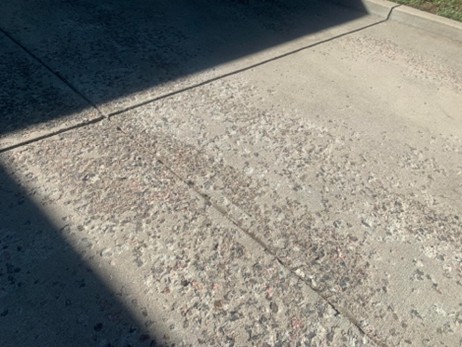Icemelter and new concrete (12 months old!)
What Causes the Chipping and Spalling of Concrete in Winter
How to Repair Chipped and Spalled Concrete Caused by Winter Weather

Winter can be harsh on concrete surfaces. Freezing temperatures, expansion and contraction from the freeze-thaw-cycle, and constant moisture exposure can lead to chipping and spalling—where the surface layer of concrete flakes, peels, or breaks away. While this type of damage is common, it’s not just a cosmetic problem; if left unrepaired, spalling can allow water and chemicals to penetrate deeper, weakening the structure over time.
Fortunately, with the right materials and methods, you can restore and protect damaged concrete. Here’s a step-by-step guide on how to repair winter-related chipping and spalling effectively.
Before beginning repairs, inspect the affected area carefully. Determine whether the damage is:
| * Superficial (only the top surface is flaking), or |
| * Structural (spalling extends deeper or exposes reinforcing steel). |
Superficial chipping can be repaired with patching compounds or resurfacing products. Deeper spalling or exposed rebar, however, may require more extensive restoration and sometimes professional help.
Proper surface preparation is critical for a long-lasting repair. Steps:
| 1. Remove all loose material. Use a hammer and chisel, wire brush, or grinder to chip away any unstable or delaminated concrete. |
| 2. Clean thoroughly. Sweep and wash away dirt, dust, oil, and salt deposits. A pressure washer works well, but make sure the surface dries completely before applying repair materials. |
| 3. Undercut the edges. Slightly undercut the damaged area’s edges to help new material bond securely and prevent future lifting. |
If spalling has exposed reinforcing steel, rust must be removed before repairs:
| * Use a wire brush or grinder to clean off rust. |
| * Apply a rust-inhibiting primer or bonding agent to protect the steel and improve adhesion of the new concrete. |
To ensure the repair material adheres properly, brush or spray on a concrete bonding adhesive to the prepared surface. Allow it to become tacky (as per manufacturer instructions) before applying patching material.
For shallow chips and flakes (less than ½ inch deep):
| * Use a polymer-modified cement patching compound or vinyl concrete repair mix. |
| * Apply with a trowel, pressing firmly to eliminate air pockets. |
| * Smooth and feather the edges to blend with the existing surface. |
For deeper spalls (½ inch to 2 inches deep):
| * Use a high-strength repair mortar or epoxy-based repair product. |
| * Apply in layers if necessary, allowing proper curing between applications. |
If large areas are affected, consider resurfacing the entire slab with a thin overlay or self-leveling resurfacer. This provides a uniform finish and extends the concrete’s lifespan.
Curing is essential for strength and durability.
| * Keep the repaired area moist and protected for at least 24–48 hours. |
| * Avoid direct sunlight, freezing temperatures, and heavy use during curing. |
| * Follow manufacturer recommendations for temperature and humidity conditions. |
Once the repair is fully cured, apply a penetrating concrete sealer.
| * Use a silane or siloxane-based sealer, which repels water while allowing the concrete to breathe. |
| * Sealing prevents moisture and salt from re-entering the concrete, helping to reduce future freeze–thaw damage |
To keep repaired concrete from chipping again next winter:
| * Avoid harsh deicing salts; use sand or non-chloride deicers instead. |
| * Apply a fresh coat of sealer every 2–3 years. |
| * Clean concrete surfaces regularly to remove salt and grime buildup. |
| * Ensure good drainage so that water doesn’t pool or freeze on the surface. |
Repairing chipping and spalling concrete caused by winter weather is a straightforward process if done correctly. By cleaning thoroughly, using high-quality patching materials, curing properly, and sealing the surface, you can restore both the appearance and strength of your concrete.
Taking the time to fix the damage early—and protect it before the next freeze—will save you from costly repairs in the future and keep your concrete looking and performing like new for years to come.